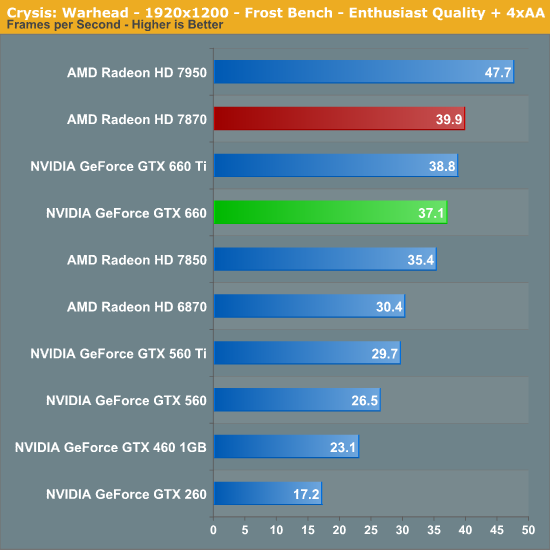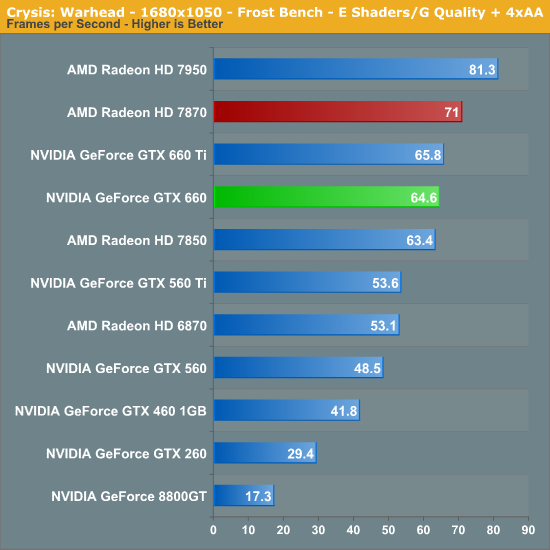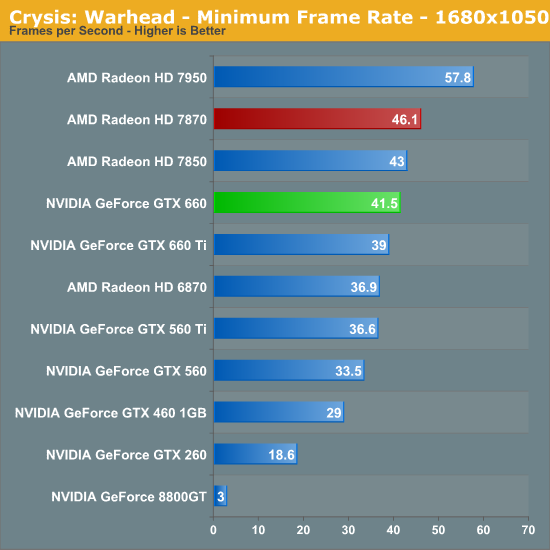The NVIDIA GeForce GTX 660 Review: GK106 Fills Out The Kepler Family
by Ryan Smith on September 13, 2012 9:00 AM ESTCrysis: Warhead
Kicking things off as always is Crysis: Warhead. It’s no longer the toughest game in our benchmark suite, but it’s still a technically complex game that has proven to be a very consistent benchmark. Thus even four years since the release of the original Crysis, “but can it run Crysis?” is still an important question, and the answer continues to be “no.” While we’re closer than ever, full Enthusiast settings at a 60fps is still beyond the grasp of a single-GPU card.


Crysis has been a game that has consistently penalized Kepler for its lack of memory bandwidth. Nowhere was this more evident than the GTX 660 Ti, which thanks to its memory bus reduction took a significant hit. But as we alluded to in our introduction, there’s a corner case where the GTX 660 is going to be able to easily keep up with the GTX 660 Ti: ROP and memory bandwidth-bound situations. As a result we’re looking at the best case scenario for the GTX 660 when held up against the GTX 660 Ti, which sees the GTX 660 offer 95% of the performance of the GTX 660 Ti. Most games aren’t going to be like this, but in this one case the GTX 660 may as well be as good as the GTX 660 Ti as far as performance goes, which goes to prove just how bottlenecked Crysis is by memory bandwidth.
Looking at a more meaningful comparison, because the GTX 660 doesn’t take a memory bandwidth hit compared to the GTX 660 Ti, the resulting card is much more resource balanced which in turn impacts AMD’s ability to lead in this benchmark. AMD once again wins here with the 7870 taking the lead, but only by a relatively modest 7% margin. This is the first time we haven’t seen a comparable AMD card lead by a significant margin in this generation, which for NVIDIA is an improvement though still not a reversal of fortunes. At the same time however NVIDIA isn’t doing too much better than the 7850 here, beating AMD’s lesser 7800 by an even more modest 5%.
As for NVIDIA’s older cards, the generational performance gains are in-line with what we’ve already seen out of the other GTX 600 cards. Compared to the GTX 460 1GB for example, a card that launched over 2 years ago at the same price, performance is up by 50-60%. But unsurprisingly this is less than the performance gain going from the 8800GT to the GTX 460, a similar timeline jump that saw performance more than double. At the very least NVIDIA certainly has the 8800GT licked at this point (by nearly a factor of 4x), but this means they’re also at risk of perpetuating longer upgrade cycles for current GTX 460 owners.


Moving on to minimum framerates, our results are almost the same with one interesting twist: the GTX 660 is now beating the more expensive GTX 660 Ti. Why? As we mentioned earlier, because of the higher core clock the ROPs on the GTX 660 actually have a greater theoretical throughput than the ROPs on the GTX 660 Ti. Since we’re not seeing any other factors that would explain this difference (i.e. drivers) it’s very likely that the GTX 660’s faster ROPs are giving it the advantage here.
Though while this is enough to push the GTX 660 ahead of the GTX 660 Ti, it’s not improving the GTX 660’s situation relative to the 7800 series at all. The GTX 660 is still closer to the 7850 than it is the 7870 here.










147 Comments
View All Comments
Zds - Saturday, September 15, 2012 - link
"Reference clock" is very different from "reference PCB". The operative words are "clock" and "PCB", not "reference".Redshift_91 - Wednesday, September 19, 2012 - link
a superclocked card is not reference clocked, thus the keyword is "reference". Unless you're going to argue that a superclocked card is reference clocked and thus the very idea of overclocking is thrown out the window.guidryp - Thursday, September 13, 2012 - link
"NVIDIA has spent a lot of time in the past couple of years worrying about the 8800GT/9800GT in particular"I am still using a 8800GT without much need to upgrade. I don't play any new games so I really can't justify an upgrade. Though of course you get that upgrade itch. So the first thing I wondered was, how much power/noise compared to my 8800GT (I have giant slow fan on mine).
Anonymous Blowhard - Thursday, September 13, 2012 - link
Now that the 600-series has gotten a firm foothold, older cards like the GTX460 have been available for around $100 if you're patient enough to wait for sales and rebates.Pick one based on the NV reference design if you're concerned about noise; I've had models from MSI and EVGA that both performed admirably in terms of noise and temperature. Blower-style fans can be extremely loud if you buy the wrong model (ZOTAC) so do your homework.
I came from an 8800GT myself and didn't feel the need to upgrade, but there's a definite benefit even in "low end" games based on Source/UE3. The ability to crank up the details/AA and still hold a solid 60fps is wonderful. Well worth the money.
DanNeely - Thursday, September 13, 2012 - link
buying a 2+ generation old high end card is almost never a good idea. What you save upfront over an equivalent lower mid range card is quickly lost due to the significantly higher power draw.rarson - Friday, September 14, 2012 - link
Huh? How expensive is electricity where you live? I can't imagine the power difference making up the cost difference in less than 2 years of constant use.I replaced my 3870 with a 6850 a few months ago, and it actually uses a bit less power at idle, which is where my GPU spends the bulk of its time, so I'm actually saving a tiny bit. Sure, the 460 uses more power under load, but the 880GT uses significantly more power than the 460 during idle (about 20W!).
CeriseCogburn - Thursday, November 29, 2012 - link
If you're worried about 20 watts at idle, you're definitely an amd fanboy.Probably something else too I won't mention since humiliating yourself is already a public past time.
gamara - Thursday, June 6, 2013 - link
20W x 2 days is 1 KW hr. 15 KW hr a month, 180 KW hrs a year. At $.10 a KW hr, that's $18. In California, some places it runs almost triple that, so if you use So Cal Ed, and are in Tier 3 or 4, you pay almost $50 a year extra for those 20 watts.guidryp - Friday, September 14, 2012 - link
I am patient enough to wait for the gtx 660 to get down to $150.If I do upgrade, one thing that is a must, is getting 3+ monitor capability.
I currently drive my TV and desktop monitor, and would like a second desktop monitor.
Here the power usage looks line line with the 8800GT and NVidia finally allows 3+ monitors.
raghu78 - Thursday, September 13, 2012 - link
GTX 660 is actually weak competition. Nvidia's pricing sucks . USD 200 would have really made it an amazing card. Performance wise its stuck between the HD 7850 and HD 7870 but pricing wise its nearer to HD 7870. the GTX 660 is up against a faster chip in the HD 7870. and needs a price correction . GTX 660 OC matches a HD 7870http://www.techpowerup.com/reviews/ASUS/GeForce_GT...
Also anandtech's gaming suite is quite out of date. They are testing Portal 2 which is useless and don't have a single game released in 2012 like Alan Wake, Max Payne 3, Dirt Showdown, Sniper Elite V2, Diablo III, Sleeping Dogs. most sites have started including newer games . hardocp has included sleeping dogs. techpowerup has included alan wake, sniper elite v2, max payne 3, diablo III. techreport has max payne 3 and dirt showdown. And to state that GTX 660 is faster than HD 7870 or the better card with such an obsolete suite is ridiculous